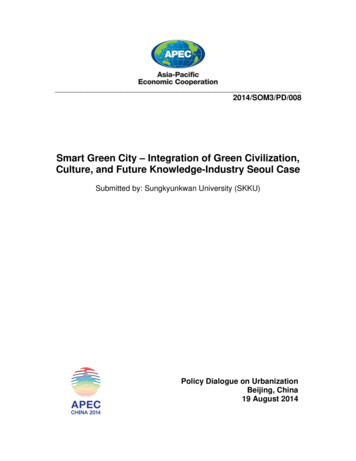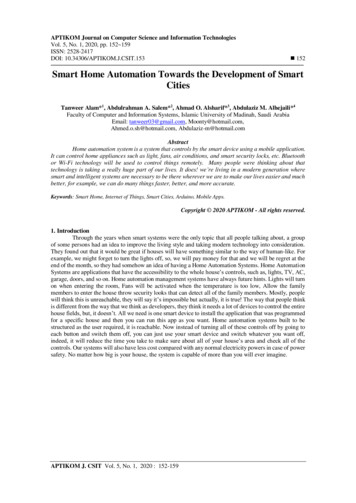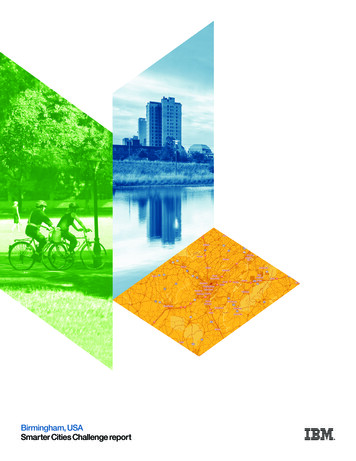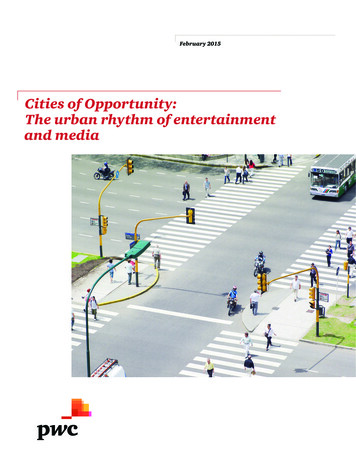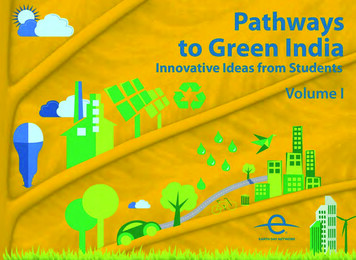
Transcription
Pathwaysto Green CitiesInnovative Ideas from Urban IndiaVolume II
2October 15, 2016Dear ReaderGrowing out of the first Earth Day (April 22, 1970), our organization Earth DayNetwork now works with over 50,000 partners in 196 countries to broaden,diversify and mobilize the environmental movement. More than one billionpeople participate each year in Earth Day activities making it the largestcivic observance in the world.Today marks World Students Day.In keeping with our conviction that Earth’s future relies on developingenvironmental learning opportunities for youth of all ages and backgroundsso that they can be wise stewards of the environment that sustains us today,and for the future, Earth Day Network, India, has put together this eBook.It showcases innovative ideas students have adopted to green India.Many of these are related to waste and water management, others toincreasing the green cover, and more.We invite you to read about these novel methods that have been adopted.All are replicable in your areas as well. We have provided the contactinformation for each of the persons written about so that you can touchbase with them to get additional details about the technicalities involved.We hope you enjoy reading the 22 case studies. Many more have come in,which we will keep for subsequent volumes. In fact, if you know of others,do have the persons contact us at earthdayindia@earthday.org.We are very grateful to the many people who sent in material and to those thathelped with editing. We would also like to thank Wysiwyg Creative Arts that soreadily came forward to design the book for us as part of their Corporate SocialResponsibility program.Regards,Denis Hayes"Chairperson""(Emeritus)Kathleen Rogers"President""""Karuna A SinghCountry Director, India
INDEXSl No!!Innovative Green Initiatives by Students!1"""!A Music Room of Tetra Paks!St Mary’s School, New Delhi!!042""""And Out Poured Water!Ashram Pathshala, Sabag!!073""""Back to Our Roots! !!!Eco-Reserve Attapaddy, Attapaddy!!4""""Does the Planet Notice?! !!Seth MR Jaipuria School, Lucknow!5"!"!Earth Murals" ""Sri Sri Academy, Kolkata!6"!"!Eco-Friendly Festival!!!!Seth Jyoti Prasad Vidyalaya, Daund7"!!"!!Empowering the Less Fortunate""!22Shaheed Sukhdev College of Business Studies,Delhi8""!""!e-Waste" """"!!Lioness Karnavati MH Hindi Higher SecondarySchool, Ahmedabad259"!"!Flora Draws Back Students!!!Government High School Dhalwari, Una2810""""For the Students, By the Students!Digital School, Visakhapatnam!3111"!!"!!Have You Seen the Trees?! !!Indraprastha College for Women,University of Delhi, Delhi!!!!Page No!1013161934Sl No!!Innovative Green Initiatives by Students !12"!!"!!Mr Cool Calculator! !!"Bharat Mata English Medium HigherSecondary School, Bilaspur""3713"""!Project 1600"""""Shree Vasishtha Vidhyalaya, Surat!!4014""""Rare Gangetic Dolphins! !!!!Dolphin Conservation Education Program, Varanasi4315"!"!Respect for Mother Earth! !St Mary's School, Kota!!!4616""""Saniya’s DunIYa"!!Loreto House, Kolkata!!!4917"!!"!!Tackling a Burning Issue! !!!!Hargovandas Lakshmichand College of Commerce,Ahmedabad5218"!"!Through the Camera’s Eye!!!!Dhulagori Adarsha Vidyalaya, Dhulagori5519"!"!Towards A Greener Education! !!!National Public School Koramangala, Bengaluru5820""!"!!Transforming a Cesspool Into a Garden!!Rajeshwari Karuna Higher Secondary School,Rajnandgaon6121""""Video Pledges! "!!Paryavaran Mitra, Ahmedabad!!!6422""""Zero Waste Himalaya"!!Zero Waste Himalaya, Gangtok!!!67!Page No!3
A Music Room ofTetra Paks
Section 1On a visit to his alma mater, Aditya was eagerly looking forwardto a changed scenario. Sadly, things were just the same. Full volumepractice sessions in the music room were still a no-no. ‘Soundproofingis just too expensive,' the administration explained. Music lessonscontinued to have the caveat ‘No one else should get disturbed.'A Music Roomof Tetra PaksAditya Bali is an alumnus of St Mary's School, New Delhi. He fondlyremembers his school days, in particular, the music room and the happyhours he spent there. He recalls how one would be immersed in playingthe scales on an instrument or trying out one's vocals when there wouldbe that invariable knock on the door and a teacher would say ‘Pleaselower the tone, my students are getting disturbed,' or ‘Sssh, examsare going on. Practise at another time.'‘This was frustrating. One had to constantly tiptoe one's talent aroundothers getting disturbed. No full-throated renditions, as my schoolmatesand I saw divas present and so wanted to emulate, nor thoseinstrumental dynamics where decibels went from soft to loud andeven louder,' Aditya says.Something had to be done. Aditya was eager to find a solution thatcould contain sound within the music room and at the same timebe good for the community, the environment, and the world. Possible?It amazingly was! After much research, Aditya came up with aninnovative but simple plan. He would add a soundproof layer to thewalls of the music room and (hold your breath) this was to beconstructed entirely out of trash—Tetra Paks discarded after theircontents had been enjoyed. His studies confirmed that using thesecould effectively minimize the acoustics at a very low cost. No rawmaterial was to be purchased. Just throw-outs collected.The environment would also benefit as reusing discarded itemswould reduce the already heavy burden on landfills.Aditya says the collection and mobilization of resources were the mainchallenges he faced. Hence, the first thing he did was to draw in a largenumber of student volunteers to organize drives to collect discardedTetra Paks. Tetra Pak vendors and St Mary's School authorities alsocame forward and the number swelled to around 80 people. ‘The NGOSwechha also lent major support,' Aditya says.In the first phase, 7,500 Tetra Paks were collected from five schools.These were then thoroughly washed. The water used in the cleaningprocess had its pH balance tested and neutralized and then reused towater the school lawns, thus not wasting it. 6,750 of the packs collected5
were found to be usable. These formed the first ‘bricks' in the innovativeconstruction. Each Tetra Pak was filled with a combination of sawdustand Neem (Azadirachta indica) leaves. Aditya had carefully chosenthese materials after much consideration. The innate cellulosic qualityof sawdust makes it an effective natural sound absorber. Its maximumair gaps provide a synergistic effect that isolates sound. Sawdust isalso readily available where cutting, grinding, and drilling of wood takesplace. Aditya says, packing it into the Tetra Pak ‘bricks' had another bigbenefit—it helped reduce respiratory diseases and other severe healthhazards that result from sawdust freely flying around. Including Neemleaves in the ‘bricks' assured good prevention against termite infestation,as the leaves are traditionally recognized as natural insecticides.Finally, the finished Tetra Paks were fixed onto the walls and theroof of the music room. To ensure that soundproofing was optimized,an irregular surface was created on the walls by lining them with anadditional layer of empty egg cartons. Lining the windows and thefloor with old blankets further blocked out the sound.It was now time to test if the newly fabricated music room was indeedsoundproof. Using the software Reaper Daw, there was confirmationthat the noise level was around 17 percent lower outside the roomas compared to inside. Guitars, drums, and bass could now be playedwith great amplification. The oft-heard refrain ‘Please, you are disturbingus,' was no longer heard and the students now had a music roomwhere they could practice to their hearts' content.‘The International Award for Young People,' constituted by the Duke ofEdinburgh and British Council, followed, as did several others.Aditya's story confirms that solutions to problems don't always needpots of money. A brilliant idea works. He is pleased that St Mary'snow has a soundproof music room and proud that the projectis benefitting the environment as trash finds a valuable use. ‘I hope thatothers will also be inspired by believing, as I do, that our environmentis the cradle of life and one should work towards protecting it,'Aditya says.Aditya is now working to develop a full-scale entrepreneurship venturethat could expand the soundproofing technique he has developedfor use in factories, conference rooms, and performing arts spaces.Aditya BaliAlumnus, St Mary’s SchoolNew Delhi"adityabali1995@gmail.comWhy wouldn't the results be amazing? After all, with the meticulousplanning and concerted efforts, success was assured. Aditya Baliwas recognized for his ‘Tetra Traps Timbre—Constructive Reuseof Tetra Paks' project with an ‘Influence Fellowship' from Swechha.6
And OutPoured Water
Section 2And OutPoured Wateris not usually a trait youth have. They live in a world where ‘now’ ismost important. This need for quick action actually proved useful fortheir water-deficient school. The students put their heads together to finda feasible solution. They spoke to their elders and discovered that therewas an indigenous method to make soak pits at a much cheaper cost,and that too, within a short time of just six hours. The method was to diga 5x5x5 feet hole in the ground close to the defunct tube well and line itat the bottom with a layer of bricks, ensuring that a hole was leftexposed. Over this, construct a layer consisting of pebbles, rocks,broken pieces of bricks and some sand. Then place an earthen potwith some jute rope inserted in it. Lastly, use brick pieces to wedge in thepot and rope so that the rope remains vertical and the pot doesn’t move.Sabag is a village in Chhattisgarh State. It is a water scarce areawhere year-by-year, the water table levels are dropping lower and loweras more and more bore wells are dug. The severity of the problem hita group of students from Ashram Pathshala on the day they crankedthe hand pump at school and not a drop flowed out. They had heardof tube wells running dry in other schools but now reality washitting home.Once all these stages were completed, the soak pit was ready for use.With bated breath, everyone waited to see what would happen whenthe tube well’s handle was cranked. Would a miracle take place beforetheir very eyes? It indeed did. The pump that couldn’t provide a singledrop of water a couple of days ago, sprung into benevolent mode again.There were shouts of joy as out poured water. A trickle, to begin with,that slowly gathered force and turned into a sizeable flow. Soon reportsstarted coming in that tube wells in the periphery also had water.The school’s tube well running dry was a serious issue, since themunicipal corporation supplied water for just two hours a day.Something had to be done. The school authorities called in contractorsto develop soak pits around the existing tube well so that water couldpermeate down and recharge it. However, all the cost estimates theyreceived were way beyond what the school could afford. The authoritiesshared their helplessness with the students and asked them to bearwith them till such time as when funds could be collected. But patienceMany were skeptical and wondered if it was just a brief lucky strike thatwould last a couple of days. People couldn’t believe that such a simplemethod could give results. The students anxiously waited for themonsoon rains to arrive to prove they were right. And they were.A careful monitoring of the soak pit showed that it could absorb 500 litersof water per day. Experts estimated that the soak pit would continue toprovide water for the next 5–6 years.8
What a boon this has been for the students who earlier went thirstyand didn’t have enough water for washing their hands, nor for the toiletsin the school. The students understand how precious water is andso have helped construct similar soak pits for others as well. Till date,350 soak pits have been dug across the state in places such asAmbikapur, Balrampur, Bastar, Bilaspur, Raipur and Raigarh. Studentsgather around each soak pit and sing a song, the lyrics of which buildawareness about the need to save water. Even those who don’t knowall the words join in the chorus that eulogizes water.Uttam Kumar Tamboli and Devopriyo GangulyStudents, Ashram gmail.comEach time the people of Sabag hear the gush of water, they blessthe students for bringing so much relief to them. Proud beneficiariesnow loudly use the new salutation ‘Jal Ho, Jai Ho’ (may there be water,may there be victory) when they greet each other. ‘Now everyoneis eager to save each and every drop of water. We are happy thatour project has brought about behavioral changes among people,’the students say.Inspired by the success of the project, and with local administrativeand municipal bodies now supporting it, plans are in place to construct1,000 more soak pits. 240 schools have expressed interest in beinga part of the project. With all of these institutions participating, it isestimated that around 86,000 students will turn Stewards for Water.This work by students to conserve water has got wide acclaim.Commendations include those from the Okayama City Award, in Japan.The Office of the President of India has communicated to them thatthe Hon’ble President of India would like to meet with the students.The project has also been shortlisted for the international ‘Water andSustainability’ competition organized by UNEP to be held in Parisin October 2016.9
Back toOur Roots
Section 3dried up and the remaining one is just a narrow strip, with noresemblance to its former voluminous self.Back toOur RootsAttappady is in Kerala State. Some time ago, a vibrant rainforest ofabundant growth stood here. It included plants that the locals turnedinto efficacious herbal medicines. Three gushing rivers meanderedthrough Attappady.Over the years this once sylvan area has been negatively transformed.Today the eye sees more built-up spaces and less green ones asthousands of trees have been cut down to make room for the demandsof expanding infrastructure development. Doing away with trees hasbrought about a change in the prevailing weather conditions. A drierclimate for one, as fewer trees are there to attract rain clouds to drenchthe land. With reduced vegetation to absorb heat generated by humanactivities, average temperatures are increasing. Two of the rivers have‘The Society of Jesus,’ a Roman Catholic order of priests and brothers,commonly referred to as ‘The Jesuits' run educational institutionsin Attapaddy. Wherever they go, the Jesuits aim to provide holisticeducation. In Attappady they examined ways to transform degradedland into a verdant one. A 23-acre barren plot, where earlier a rainforeststood, was identified and purchased. The idea was not to developsystematized farming but to let nature spring back unhindered.‘Could these stark acres be turned into a forest of abundant trees,bushes, and herbs?' That was the question the Jesuits asked.The first step was to identify flora that the people of Attappadyremembered as traditionally growing there. The locals, many of whoare indigenous people, whose forefathers believed in livingin harmony with nature, were asked to try and recollect the namesof the plants that their elders spoke about. That was before urbandevelopment overran the space and the tie with nature was snapped.A preliminary list of species, based on majority agreement was puttogether. As climate and soil conditions had altered over the years,expert botanists were called in to confirm whether the area remainedconducive to the growth of all the species mentioned, or would somenot survive in the changed conditions.Once a final selection was agreed upon, ‘Eco-Reserve Attappady'was established in the 23-acre plot.To ensure that the younger generation connected with nature and carriedthe mantle of responsibility for it, youth were encouraged to take on an11
active role. All students were invited to be a part of Eco-ReserveAttappady—not just those from the institutions that the Jesuits ran,but any that expressed interest. Meetings were arranged where theyouth shared their views on best strategies. Experts helped the youthunderstand why it was in their interests to plant, protect and conservethe green cover: after all, they had the larger stake as they had so manymore years to live.As we speak, hundreds of students from several government and privateacademic institutions around Attapaddy are actively participating in‘Eco-Reserve Attapaddy.’ They come from 40 schools, 2 colleges,1 Polytechnic, and 1 Industrial Training Institute. The students have freeaccess to the space and work in teams, or even individually, to growback the forest. To strengthen their bond with nature, periodic campsare held within the developing forest. Many students camp there andget a chance to touch, smell, see and experience nature in all its glory.Many teachers use the forest as a laboratory to provide hands-onlearning and regularly bring their charges during school and collegehours for a first-hand experience of the wild. Formal lectures andseminars are organized to further expand understanding about thecorrelation between increasing the green cover and reducing climatechange. One of the notable results of Eco-Reserve Attapaddy has beenthe revival of the festival of Kambalam. This used to be a regularcelebration of nature's bounty. For years, it had stopped for, ‘Where wasthe bounty?' Now students have helped revive it. Along with thetraditional thanksgiving rite for the harvest, there is also joyous singingand dancing.rewarding at the same time, as the area gradually turns greener andgreener. It is wonderful to see this 23-acre land now visited by deer,wild boars, peacocks, rabbits and many other animals that stroll in fromthe adjacent forest reserve. Leopards and elephants also come by.Elephants usually stomp in to quench their thirst during summer months.Once they damaged some pipelines in their search for water. To avoidthis, we have constructed open tanks that serve as watering spotsfor the elephants.'‘If the people of Attapaddy can turn around denuded area, why can'tothers?' Fr Antony asks. His recommendations for success includea well-defined plan that is backed by strong commitment and theenthusiastic support of youngsters.Fr Lenin Antony SJDirector, Eco-Reserve AttapaddyAttapaddypsantonysj@gmail.comFr Lenin Antony, SJ, Director, Eco-Reserve Attapaddy says ‘Theestablishment of Eco-Reserve Attapaddy has been challenging, but12
Does thePlanet Notice?
Section 4Planet Notice?' that called upon all humans to act against climatechange. Every act counts, no matter how small, was what they nowunderstood. The decision was taken. The students would not sit backand let things slide but do their bit to help reduce one of the mainscourges that bring about climate change—carbon footprints.Does thePlanet Notice?A group of students from the Seth MR Jaipuria School in Lucknow,Uttar Pradesh, were amazed when they realized that adults were nottaking climate change as seriously as the issue warranted. The studentshad learned in school that climate change knows no boundaries andaffects all life forms—from the smallest algae cells floating in the oceans,to large mammals. No place on earth provided a safe haven from itspotential impacts. They wondered if adequate strategies to mitigate itwere in place. Looking at the changing weather conditions, rising sealevels, melting glaciers, increased precipitation, they concluded thatthe answer was definitely ‘no'.Imagining the horror of environmental tragedies that could unfold,the students decided to take action. ‘Earth is huge. Would the planetbenefit by our small efforts of not using plastic bags, or carpoolingto school or would these be acts too minuscule to make a difference?'they wondered. Inspiration came by reading the book ‘But Will theThe students say ‘We formed a group and n
Oct 15, 2016 · that slowly gathered force and turned into a sizeable flow. Soon reports started coming in that tube wells in the periphery also had water. Many were skeptical and wondered if it was just a brief lucky strike that would last a couple of days. People couldn’t
